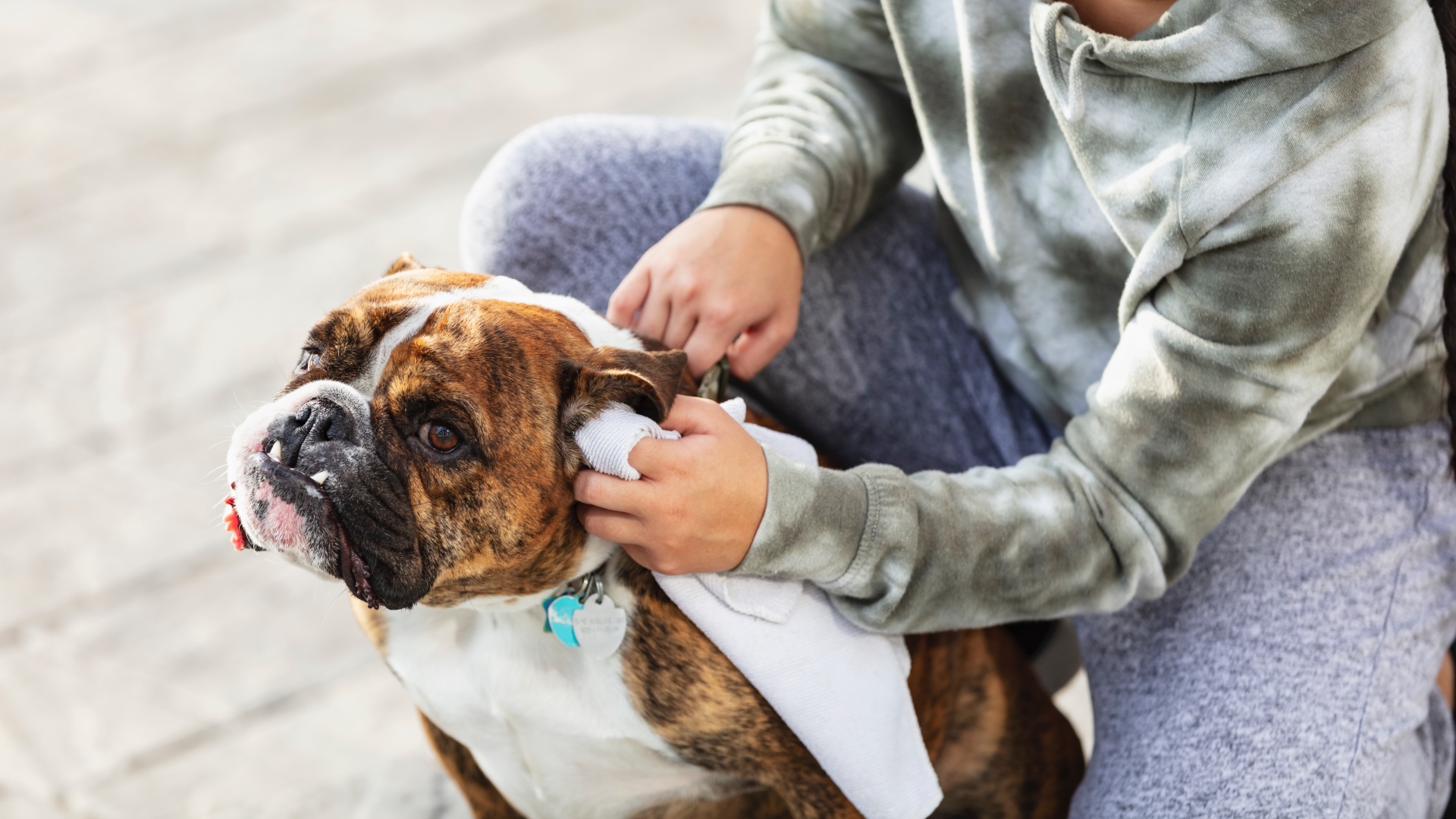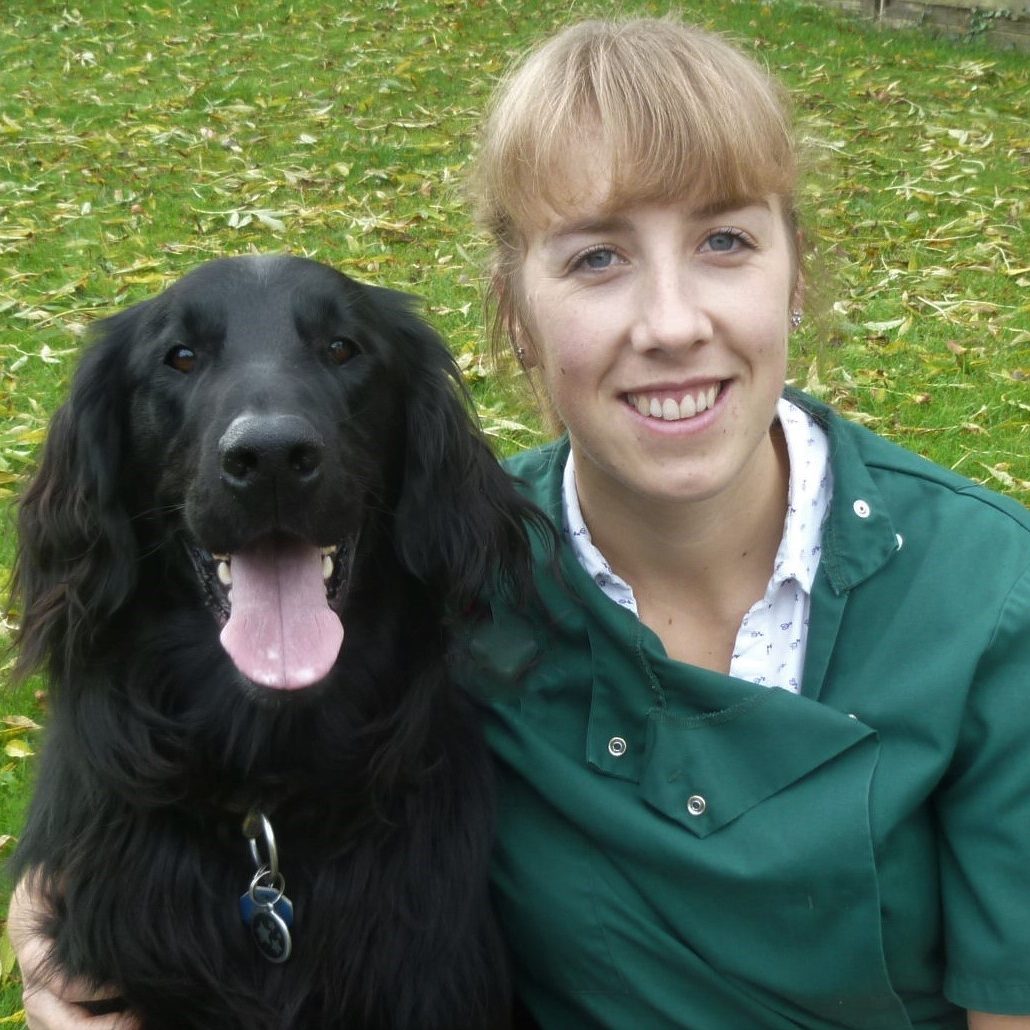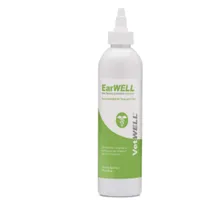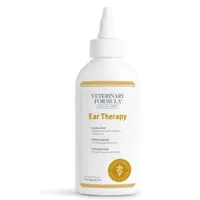How to clean a dog’s ear (tips and tricks from a vet)
What’s the best way to clean a dog’s ears? We spoke to a vet to find out!

If you need to clean a dog’s ears, you may be wondering how on earth you go about doing it. Given that most dogs will need their ears cleaned at one time or another, it’s a skill well worth learning.
While there’s no need to clean your pup’s ears on a daily basis, if you have a breed that’s prone to getting filthy and you’d like to avoid costly visits to the vet or groomer, knowing how to do this job yourself can be super helpful.
Although dirty ears are something you can deal with yourself at home, medical issues such as ear infections in dogs or ear mites in dogs will require treatment by a vet. So if you notice that your pup’s ears are smelly, red or waxy, it’s important you don’t try to clean their ears yourself.
However, if what you’re dealing with is just a build up of every day dirt, debris and grime, Dr. Hannah Godfrey (with the help of Dr. Rebecca MacMillan) has shared her top tips for cleaning your dog’s ears at home, including what you should use and the exact process you should follow. Let’s take a look…
What should I use to clean my dog's ears?
Never put anything into your dog’s ear that isn’t specifically meant for that purpose because it could cause your dog pain or damage their inner ear. It’s also important to never insert cotton buds or any other object that could accidentally go too far into the ear canal and cause damage. This is especially important because dogs are very mobile and are unlikely to stay perfectly still.
Your vet will be able to recommend an ear cleaner solution that is suitable for regular use, as well as other cleaning products that may be more effective in dogs with specific conditions like allergies, yeast overgrowth, or recurrent ear infections.
There are various types of ear cleaning products, most are liquid solutions or foams that lift the wax from the walls of the ear canal, but there are also wipes, which can be effective at cleaning the outer part of the ear.
Get the best advice, tips and top tech for your beloved Pets
VetWELL Ear Cleaner for Dogs and Cats | Amazon
Gently clean and deodorize your dog's ears with this vet formulated solution that's safe for daily use and is great for eliminating the build up of wax, fluid, dirt and debris.
Cleaning dogs’ ears without solution
If your furry family member has dirty or smelly ears, you might not want to wait for a vet appointment before giving them a good clean. But if you haven’t got a specific ear cleaning solution for dogs, is there anything that you can use which is safe and won’t harm or hurt your dog?
Well, the answer is no, not really. You should never put anything into your dog’s ear without checking with your veterinarian first. Some solutions will be ineffective, and others can cause your dog's ear to become irritated or painful. Also, many home remedies for DIY ear cleaners contain strongly alkaline or acidic ingredients like vinegar or bicarbonate of soda.
These could cause your dog pain, and if your dog's eardrum isn't intact might even cause serious damage to the fragile tissue in the inner ear. This could result in permanent hearing loss for your poor pooch, so it’s important to be careful when it comes to caring for their ears.
Another common ingredient of DIY ear cleaning solution is olive oil, and it's easy to understand why when it's so often recommended in people. However, if your dog's ear is infected or inflamed, olive oil is unlikely to be of any benefit at all and may make it more challenging when you do take them to the vet for them to see what's going on down there!
The best advice is to avoid applying anything to your dog's ear until your veterinarian has given them a check-over and only used products recommended by your vet.
How often should I clean my dog's ears?
If your dog is prone to ear infections, is one of the breeds that are made for swimming and regularly hits the water, or has particularly waxy ears, it is best to clean their ears regularly and mark it on the calendar. The frequency of cleaning that is needed depends on the individual dog, how much wax they naturally produce, and their lifestyle. Dogs who swim should have their ears cleaned after each dip in the water, whereas, if your dog doesn’t swim, but is prone to waxy ears, clean their ears weekly or every two weeks, depending on how quickly you can see wax building up.
If your dog’s ears are clean and comfortable, they do not need cleaning. But even if your dog seems to have clean ears most of the time, it’s still worth checking regularly to make sure they aren’t waxy, sore, or smelly.
How do I clean my dog's ears?

Just like when it comes to how to brush a dog's teeth, cleaning your dog’s ears isn’t always easy, especially on the first attempt! The steps below should help make it easier and improve your chances of success.
- Make sure you have everything that you will need nearby – ear cleaner, cotton wool, broken into small pieces, or cotton wool balls, and a muzzle if your dog needs one.
- It’s going to get messy! Find an area of the house with wipe-able surfaces, or use an outdoor, enclosed space.
- If possible, ask someone to help you by gently restraining your dog. If no one is available to help, move the dog into a corner of the room where they are unable to move around so much.
- If your dog has dangly ears, lift the ear flap straight up so that you can see into the ear canal. If they have upright ears, hold the ear in one hand.
- Using the hand that isn’t holding the ear, put the nozzle of the ear cleaner just inside the ear canal and give a good squeeze. The solution should come out and you may see some spill onto the floor – don’t fret, you’ll get to know how hard to squeeze the bottle over time.
- Put the ear cleaner down and use the same hand to massage the base of the ear, where the ear meets the head. You should hear the ear cleaner and wax squelching around. At this point, your dog may try to shake their head, which is why it's best done outside or somewhere where mess can easily be cleaned!
- Using the cotton wool, wipe away the ear cleaner and wax from the entrance of the ear canal.
- Add the cleaner again and repeat the process until no more wax is removed.
- Repeat the process for the other ear.
How to clean dog ears that are infected
Dealing with an infection as opposed to just dirt? Dr. MacMillan has the following tips when it comes to cleaning ears that are infected.
"If your dog has been diagnosed with an ear infection, then your vet may have prescribed an ear-cleaning solution as part of their treatment plan. These can help shift excess wax and allow any medicated treatments to work more effectively (e.g. topical antibiotics). Your ear-cleaning solution will need to be applied into your dog's ear canal, not the external part of the ear," she explains.
"Find a quiet moment to do this where you are not rushed or stressed. Remove the lid and gently insert the nozzle of the bottle into your dog's ear. You should be aiming into the ear canal, so the bottle must be angled down and slightly forward into the ear hole itself. Flood the ear canal with plenty of liquid (unless otherwise instructed by your vet). Remove the bottle and massage the base of your dog's ear well. You will feel a tube of cartilage at the back of your so massage this gently working the ear cleaner and any wax up to the top of your dog's ear hole. You will probably hear the ear-cleaning solution squelching around too! Use a large piece of cotton wool to wipe out any fluid or debris that comes out.
Repeat this in the other ear canal if required and follow your vet's instructions as to how often to clean your dog's ears. Remember to praise and reward your dog during the process."
What is the best ear cleaning solution for dogs?
"I would always advise that owners speak to their vet about ear-cleaning products," says Dr. MacMillan. "Most normal dogs never need their ear cleaning, so if your pet has an issue with wax buildup or excessive odor then they need a vet check. If your dog has a painful ear infection there is a real risk of making things worse by delaying appropriate care and purchasing over-the-counter products. Once your vet has checked there are no infections, foreign bodies, or masses/growths they might give you the ok to use a cleaning product."
Veterinary Formula Clinical Care Ear Therapy | Amazon
Created by vets, this ear solution has been formulated to help promote healthy ear canals and comes with a dropper for easy application. Ideal for daily care and weekly maintenance, it helps breakdown buildup in the canal that may be causing foul odors and itching, scratching, and head shaking.
Can I make my own dog ear cleaning solution?
You may have read that things like tea tree oil can be a helpful home remedy for cleaning dog ears, however Dr. MacMillan warns against this.
"I would never recommend that owners put any household products down their dog's ear canals. If there is a bacterial or fungal infection present, this will require proper medicated treatment. Also, if the ear drum is ruptured at all then there is a risk that any products applied could get into the inner ear causing hearing and balance problems."
When to see a vet

Sometimes ears are not just dirty or waxy, they are infected. You may have a suspicion that your dog has an ear infection rather than just wax if they are showing signs of pain, itchiness, or the ears are red or smelly. It is important to see a vet if your dog’s symptoms don’t improve after cleaning a few times, as they will be able to look inside the ear and prescribe extra medication if needed.
Once you know how, it’s easy to clean your dog’s ears. Even if your dog doesn’t need them doing, it’s worth practicing with them so that they’re used to having their ears handled – it’ll make it easier if you do ever need to have their ears done!
Alongside the tips above, we recommend plenty of praise and a few of the best dog treats to help your pup learn that having their ears cleaned is nothing to worry about.
Not just your dog's ears that are dirty? If your pup is filthy from top to tail, here's how to give a dog a bath. Or, learn about deafness in dogs.

Dr Hannah Godfrey studied Veterinary Medicine at the Royal Veterinary College London. After graduating in 2011, Dr Godfrey went on to become a veterinary surgeon, conducting surgery consultations on a range of animals at a small independent practice in Cardiff, South Wales, UK. Dr Godfrey has a strong interest in soft tissue surgery. When she’s not helping animals back on their feet, Dr Godfrey writes a number of veterinary and animal-focussed articles.

Rebecca is a vet surgeon who graduated from the Royal Veterinary College in 2009. She has a wealth of experience in first opinion small animal practice, having done a mixture of day-to-day routine work, on-call emergency duties and managerial roles over the years. She enjoys medicine in particular and she is proud to have recently achieved a BSAVA postgraduate certificate in small animal medicine (with commendation). She writes on various feline and canine topics, including behavior, nutrition, and health. Outside of work and writing she enjoys walking her own dog, spending time with her young family and baking!
Dr Hannah Godfrey is a small animal vet who graduated from the Royal Veterinary College in 2011 and began work straight away at a busy mixed practice. Initially, she treated all species, but focussed on small animals from 2014. She has a passion for soft tissue surgery, ultrasound, and canine and feline dentistry, having completed additional training in these areas.


